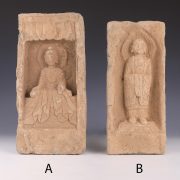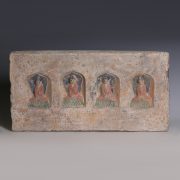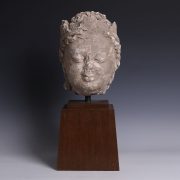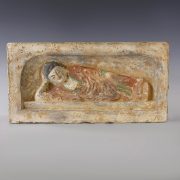Buddha
Buddhist missionaries established Chinese buddhism via Nepal and Central Asia during the Han Dynasty from around 200 BC. Until the 1st century AD, buddhist art as a whole was aniconic (i.e. did not represent the Buddha directly but only through symbols such as an empty throne, a riderless horse or footprints). Relief carving in cave temples developed but sculpture in the round was only practiced in China from the 4th century AD. Buddhist sculpture in the round developed via Greco-Buddhist art centred in Afghanistan, thus seeing some Hellenistic influence, and in China too this form saw influence from native Chinese styles. Due to their relative convergence of thought, the philosophies of Buddhism also saw influence in China from native Chinese Taoism which had some aesthetic influence. In the early Tang Period around 600 AD Buddhist art flourished with the production of many statutes in cave grottoes. While in the later Tang dynasty Buddhism was heavily suppressed, Buddhist art continued in China to evolve in tandem with China’s changing aesthetic periods.
By continuing to use the site, you agree to the use of cookies. more information
The cookie settings on this website are set to "allow cookies" to give you the best browsing experience possible. If you continue to use this website without changing your cookie settings or you click "Accept" below then you are consenting to this.



